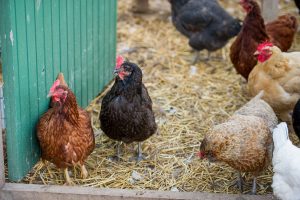Bulletin #2113, Pecking and Cannibalism by Hens: How to Stop It?
By Anne Lichtenwalner, DVM Ph.D., University of Maine Cooperative Extension
For information about UMaine Extension programs and resources, visit extension.umaine.edu.
Find more of our publications and books at extension.umaine.edu/publications/.
Chronic pecking or “picking” by other birds can cause many problems in a flock. Birds need to groom themselves and each other as an important part of their normal behavior. However, when birds are bored, grooming can get out of hand and eventually result in drawing blood or even cannibalism in the flock. Alternatively, small predatory animals (rodents, weasels, etc.) may bite birds while they are roosting, and the damage to the vent area can act as an inducement to pecking by other birds. Occasionally birds will self-traumatize by pecking. It is important to understand that the color red is a strong attractant to birds, and causes them to want to peck. Use the color red to induce feeding behavior (this is why a red waterer or feeder is helpful with chicks) but otherwise, avoid it in anything but food items.
Preventing Pecking
Pecking behavior can be due to social issues (boredom, establishing “pecking order”), attraction to a wounded area (such as bleeding from the vent), or even self-trauma due to discomfort/itching, so keeping birds busy, safe from predators and comfortable will prevent it. It is often very difficult to stop in a flock once it gets going. Using perches that are either very close to the floor (too short for birds on the floor to reach the vent of other birds), or beyond the reach of other birds standing on the floor, was found to reduce the rate of pecking in free-range flocks. However, low perches allow small predators like rats to easily bite your sleeping birds, so it is best to have relatively high perches. As well, avoiding excessive light stimulation can prevent pecking. Distractions, such as fibrous vegetables or other “toys”, can be helpful. Importantly, more space (floor space, feeder/waterer space, nest space, and perching space) may help by allowing lower-status birds to avoid more dominant birds.
Curing Pecking
Once it starts, this is difficult. Try to figure out who is the “culprit” by spending time quietly watching your birds. Note: often this is a single bird, who will show no feather lesions (although all the other birds may have them). Separating this bird may help, but sometimes you may need to get rid of that “dominant” bird. Be sure you fix the underlying causes (space, not enough distractions, perch height), or another bird will simply step into that dominant, bullying role in the flock. For the birds that have been pecked, if the wounds are not deep, using a non-irritating lotion or salve that acts as a pecking deterrent may help them heal (and avoid further pecking). Some products combine aloe vera gel with food-grade coloring to visually mask pecking lesions (blood or raw skin) and to seal up the wounds. However, just treating the wounds isn’t enough: a combination of methods including fibrous vegetables (as “toys”) and improved housing conditions are needed to minimize pecking trauma. Be sure whatever you use is safe for laying hens or for animals used for food, or talk to your vet about appropriate treatments.
Rarely, diseases or nutritional problems that cause encephalitis can be associated with pecking problems. However, management issues are more likely to be the cause. If management changes don’t cure the problem, then further diagnostic workup may be helpful. Please see the University of Maine Cooperative Extension Veterinary Diagnostic Laboratory website to learn more about sending animals for necropsy, and other poultry health issues.
Information in this publication is provided purely for educational purposes. No responsibility is assumed for any problems associated with the use of products or services mentioned. No endorsement of products or companies is intended, nor is criticism of unnamed products or companies implied.
© 2017
Call 800.287.0274 (in Maine), or 207.581.3188, for information on publications and program offerings from University of Maine Cooperative Extension, or visit extension.umaine.edu.
In complying with the letter and spirit of applicable laws and pursuing its own goals of diversity, the University of Maine System does not discriminate on the grounds of race, color, religion, sex, sexual orientation, transgender status, gender, gender identity or expression, ethnicity, national origin, citizenship status, familial status, ancestry, age, disability physical or mental, genetic information, or veterans or military status in employment, education, and all other programs and activities. The University provides reasonable accommodations to qualified individuals with disabilities upon request. The following person has been designated to handle inquiries regarding non-discrimination policies: Director of Equal Opportunity and Title IX Services, 5713 Chadbourne Hall, Room 412, University of Maine, Orono, ME 04469-5713, 207.581.1226, TTY 711 (Maine Relay System).


